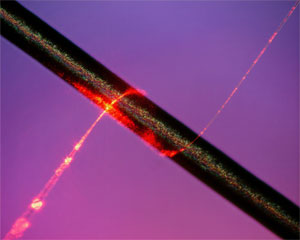TUESDAY, 15 NOVEMBER 2011
The apparatus (known as a temporal cloak) consisted of a split-time lens (a silicon device used to speed up data transfer), which accelerates light along the centre of the fibre, but slows it down near the edges. A similar lens further along the fibre induced the opposite velocity adjustments, reproducing the original shape of the light rays.The team created regular pulses of light between the two lenses, steadily collecting data from these events. The temporal cloak was then synchronised with the light pulses, and caused all traces of these events to vanish from the data stream, concealing the fact they ever took place.
The temporal cloak relies on the physical properties of light, in particular on its behaviour in tightly constrained space and time conditions. However, as a consequence of the extreme velocity of light the technique has strong limitations – the temporal cloaking spans 6 millimetres and can last only 20 trillionths of a second.
Due to these limitations, macroscopic tests of this phenomenon are currently out of reach - these would require running the experiment on astronomical length scales. Even so, the technique represents a major milestone for optical physics and invites researchers to delve deeper into the field than was previously possible.
Written by Javier Azpiroz-Korban

